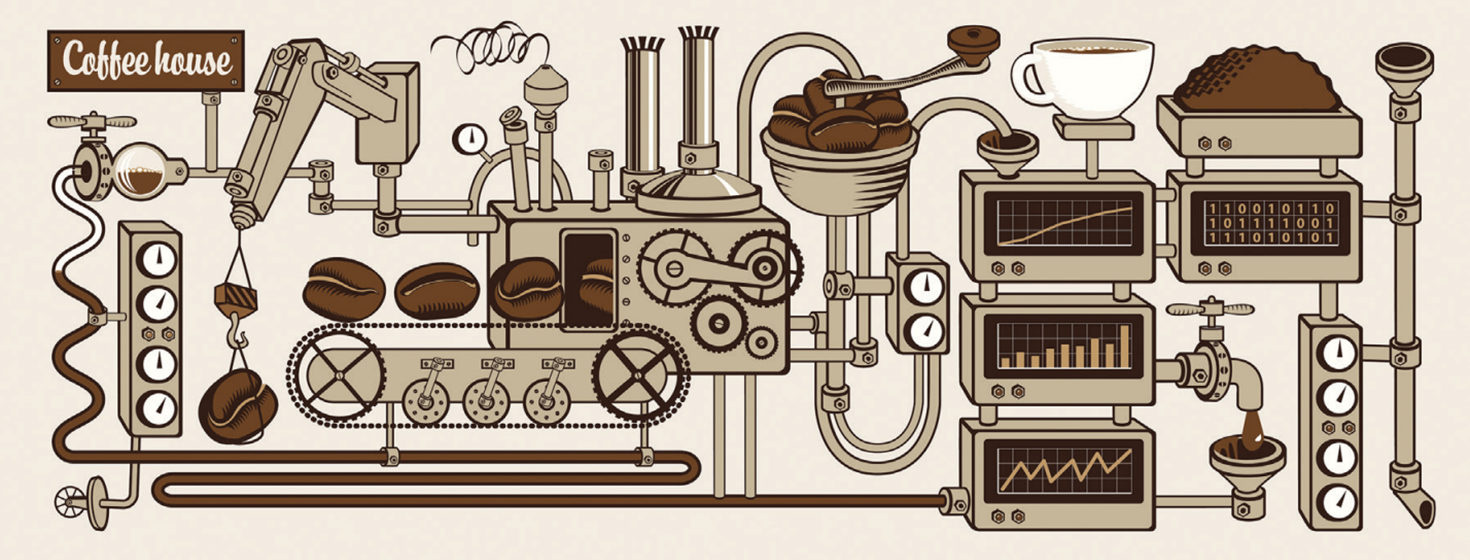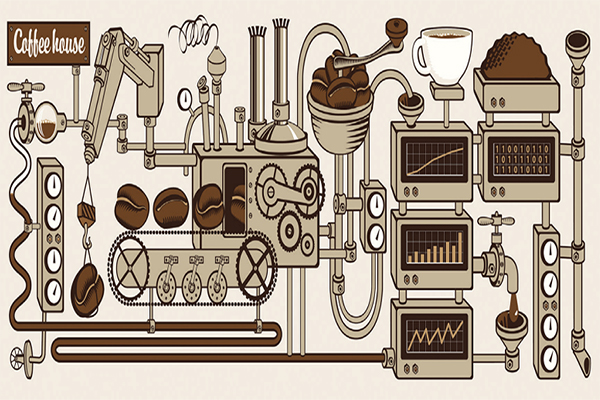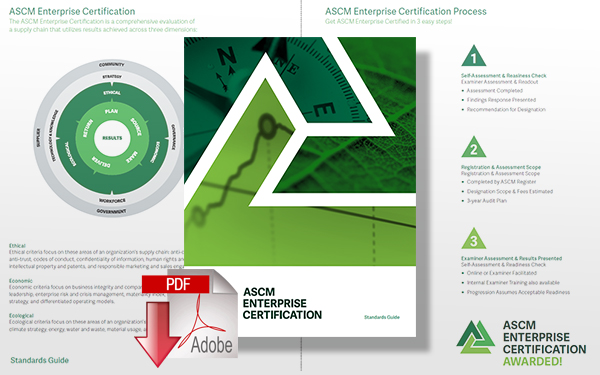Next Generation Supply Chain: Serving Up An Experience

The next generation of supply chains will be tasked with delivering an experience as well as a product.
The Experiential Supply Chain
Would you pay $15 for a cup of coffee? Now, before you answer, imagine that this is no ordinary cup of Joe.
The coffee is produced using the siphon method, a nearly 200-year-old slow-brew process renowned for its ability to deliver a delicate, clear and tasty cup of coffee.
What’s more, while the barista is making your cup, you’ll be able to see how coffee cherries are converted into roasted and ground coffee beans.
Starbucks is betting that just as wine lovers are willing to pay for the experience of tasting wines at the winery, surrounded by vineyards and winemaking equipment, coffee lovers will pay $15 to experience coffee in a new way at its Reserve Roastery and Tasting Room.
The similarity doesn’t stop there. Just as winery customers can sample unique wines that aren’t in the stores, Starbucks’ customers will be able to sample new blends and drinks before they get released to the public - drinks like Nitro Cold Brew, the Smoked Butterscotch Latte and the Cascara Latte.
Now, knowing all that, would you pay $15 for a cup of coffee? If you answered yes, welcome to the experiential supply chain, one in which supply chains are tasked with delivering more than just a product, even if that is a custom product.
Supply Chain Management Undergoing Transformation
Today, the supply chain is becoming a strategic tool that enables a business’s go-to-market strategy; and in response, it is developing new forms. These new types of supply chains have a lot to teach managers and researchers about the future of supply chain management.
If you think that the experiential supply chain is unique to Starbucks, think again.
Those of us involved in “Supply Chain Management - Beyond the Horizon,” a joint APICS (now Association for Supply Chain Management, ASCM)-Michigan State University research project, encountered several examples of the experiential supply chain in action. Since then, the team has collected numerous examples describing both the operations and the impact of this type of supply chain that form the basis of this article.
First up are meal planning and delivery startups such as Blue Apron, Hello Fresh and Plated. They allow a customer to order the recipes and locally sourced ingredients required to create a special meal. While the meal is important, it’s secondary to the experience of discovering how to prepare and share unfamiliar cuisines.
At MTailor, a customer uses a smartphone app to custom design and order shirts that arrive within two weeks. Tunespeak allows music fans to use their networks of acquaintances to drive demand for contracted artists; the site rewards these fans with goodies such as free concert tickets, special merchandise and meets and greets with their favorite bands.
Finally, consider Tough Mudder - an endurance event series in which participants test their mental and physical fitness on 10-mile to 12-mile obstacle courses. The goal is not to win but to finish the course and to help others along the way. Each of these businesses requires a unique supply chain, one that can deliver both the product and the experience that is highly valued by the customer.
The experiential supply chain is the result of several on-going developments:
- changes in the customer base;
- changes in technology;
- increasing awareness of the ability of the supply chain to be strategic; and
- the need to differentiate companies and their supply chains from Amazon.com
As we will show in this article, new emerging supply chain forms also bring with them certain major implications for firms, their business models and for how we all think about and manage supply chains. As we move into the future, we can expect to see more examples of such innovation.
The Experiential Supply Chain Concept
The experiential supply chain describes a customer relationship where the customer is involved in the design, development, delivery, and implementation of a good or service, and not just the consumption of a product. It is this involvement that differentiates this type of supply chain because the experience is unique to and valued by each customer. The experience is a combination of objective and subjective elements. The process is complete when the customer is satisfied with the resulting product and experience.
In addition, the experiential supply chain is visible during the process. At Starbucks Reserve, for instance, the consumer can see how coffee beans are converted into coffee grounds; they are also introduced to the difference in coffee making techniques - what makes a siphon-made cup of coffee different from a cup made using a French press.
With meal planning services such as Blue Apron or Plated, the provenance, or source, of the ingredients plays a critical role in the experience to customers that value locally sourced ingredients. Finally, the experience can and will vary over time and from transaction to transaction. Thus, one of the major challenges facing any firm involved in this type of supply chain is keeping the experience “fresh” - a challenge that is ultimately addressed through the combination of technology, social media, and consumer familiarity.
Before discussing the types of experiences that are typically encountered with this type of supply chain, it is important that we differentiate the experiential supply chain from servitization and the customer experiences described by recent research from KPMG.
Experiential Supply Chains vs. Servitization
The concept of the servitized supply chain was first introduced in “8 Steps to a ‘Servitized ’Supply Chain,” an article published in 2012 in CSCMP’s Supply Chain Quarterly. In this article, the authors argued that “servitization,” or a bundled package of products and services, offer greater value to the customer and can ultimately lead to more profitable relationships between a manufacturer and its customer. We see servitization as a viable strategy that is focused on providing the customer with comprehensive solutions to their problems.
For example, if your customers want light and stronger eyeglasses, they aren’t interested in buying titanium and making their own frames. Rather, they want you to provide them with a solution to this outcome. How you do it is up to you. You can focus on design, on material, on the manufacturing process or on the ongoing support of the glasses, including, say annual cleanings and a lifetime of repairs. Ultimately, what matters, in the end, is the solution. In contrast, the experiential supply chain focuses on the experience felt by the customer. This experience, as we will see later, can be one of discovery or mastery or accomplishment.
Experiential Supply Chains vs. Customer Experience
In a recent series of reports, KPMG has focused on customer experience as a critical but overlooked source of competitive and strategic advantage. Here, the focus is on how customer satisfaction throughout the entire purchasing process relates to the customer experience. This is different from the experiential supply chain, which focuses on the experience not as a measure of performance but rather as a vital component of the product created for the consumer. Remember: You’re not just buying a $15 cup of coffee, you’re part of the process of brewing it.
Understanding the Types of Experiences Experienced
To understand the experiential supply chain, you must first understand a fundamental fact - there is a difference between buying and shopping. Buying is a routine activity of a well-defined product, like placing a routine order for the same brand of coffee that you always buy. The goal is to reduce the time and cost associated with the transaction. When you sign up for a subscription service offered by Amazon, you are buying, not shopping.
Shopping is what happens when you go into a restaurant and find that you have a chance to try a new food dish or drink. It is what happens when you go to a store and find a product that you had always wanted not only available but on sale at a significant discount.
At the heart of shopping is the experience. As consumers, these experiences can be highly varied. Consider the following:
- Discovery. Discovery takes place when you find something that you wanted by accident. One of the best examples of discovery was encountered when members of the research team visited the headquarters of a fashion goods company headquartered in the American Midwest. The company began as an odd lot/ end lot jobber, buying and selling items no longer wanted by the supplier, including brand names. Because the stores had limited floor and shelf space, the company’s strategy was to turn over product quickly to make room for the next delivery: If a style was selling quickly enough, it was moved to the store’s clearance area for a final, deep discount. It turns out, customers loved shopping in the clearance areas because they could get great deals on products. Often, they visited the stores just to see what was on sale in the clearance areas. These trips came to be known as treasure hunts. As the company grew in size and inventory sophistication, management could have eliminated the clearance areas. Yet, they kept them because they recognized that the treasure hunt was an integral element of its customers’ shopping experience.
- Achievement. Achievement is a sense of accomplishment. Customers of meal planning services, for instance, experience achievement when they take something that initially appears complex and beyond their ability - cooking a new type of cuisine - and make it just like it appears in the recipe.
- Sharing. Achievement is often accompanied by sharing when others participate in the preparation and consumption of the goods or services. Sharing enables us to transform a mundane activity like making a meal into a shared experience that benefits everyone involved. The meal becomes more than eating; it becomes bonding.
- Uniqueness. Uniqueness is the ability of the supply chain to generate a custom product that is unique to a customer’s needs but is delivered quickly and at a price comparable to that of a standard product. The ads for MTailor exhort its customers to “stop wearing another man’s clothing.” This company offers the ability to create a custom-designed shirt in terms of material, cuffs, and collar and in the perfect size in less than 30 seconds using their smartphones and to have it delivered within two weeks, all for less than $80 USD.
- Entertainment/education. With this approach, the experience takes something that is mundane and makes it interesting. When Starbucks Reserve involves you in the process, the servers are educating you about how different forms of coffeemaking influence the favor of the coffee and what steps have to be done to deliver the cup of coffee. When you get that cup of siphon-made coffee, you find yourself entertained by the production process and educated by the information provided.
- Altruism. This is the experience of supporting a worthwhile or unique cause. Take Redbubble, a web-based service in Melbourne, Australia. Redbubble offers its customers the ability to place designs created by an ever-changing group of artists on covers, t-shirts, device cases, wall art, home décor and stationery (to name a few outlets). The artists own and control how their designs are used; consumers follow and support these artists through their purchases. Redbubble, by the way, makes its money from the products delivered to the customers.
In reviewing these experiences, three points come to mind. First, the list is obviously not exhaustive. Second, experiential supply chains can deliver more than one type or form of experience. Finally, the experience created is often personal and unique to an individual customer. Ultimately, this leads to the creation of a “market of one,” a situation where the customer not only feels unique but believes that a specific firm and its supply chain is best able to meet their needs. In a market of one, a company attains “p status,” or preferred status, for that customer.
Why Now?
Like many of the advances we have discussed in previous articles, the experiential supply chain is the result of several recent developments. These include advances in digital technology such as RFID and the Internet of Things (IoT), 3D printing, the cyber supply chain, social media and changes in the market. While technological changes have facilitated the advent of the experiential supply chain, the changes in the market, especially the advent of the Millennial, have propelled this type of supply chain.
The advent of the Millennial. An article by Micah Solomon in Fortune noted that 2015 was the year that the Millennial replaced the baby boomer as the critical consumer base. Numbering about 80 million, Millennials, now make up over 25% of the U.S. population. More importantly, Millennials are fundamentally different from baby boomers. For instance, they care about your company and its values; they expect your technology to work; they are social consumers; they demand convenience; and, increasingly, they expect speed.
More importantly, as James Wallman noted in “Stuffocation: Why We’ve Had Enough of Stuff and Need Experience More Than Ever,” Millennials have grown up with abundance. Consequently, they have enough stuff; what they now want is something more - a true, personalized experience. This last demand is a reflection of how Millennials are contributing to the emergence of the experiential supply chain.
The Next Frontier in Innovation
The real significance of the experiential supply chain is that it represents a new form of innovation. Past research has shown us that there are four major forms of innovation: (1) product; (2) process; (3) customer experience; and, (4) business model. The more integrative the innovation, the bigger its impact on revenue and stock price growth.
To this list, let’s add supply chain innovation. This fifth form of innovation changes how a product or service is delivered to the customer. It affects not just the last mile but also the last inch in the delivery process - the case of a meal delivery service it’s the “oohs and ahs” when the newly cooked meal is plated and placed on the table.
Supply chain innovation has become possible because of certain changes. These include the technological changes we referenced above as well as the increasing awareness of the supply chain as both a marketing vehicle and a strategic (rather than tactical) tool that enables a business strategy. After all, it is the supply chain, and not marketing or finance, that determines the moment of truth experience received by the customer. As managers become aware of these factors, they have begun to experiment and focus their innovation activities on the supply chain. Hence, the experiential supply chain.
So What Does This Mean For Supply Chain Management?
Based on the companies that have come to our attention, we have concluded that experiential supply chains offer supply chain managers some very important lessons and insights - namely:
- The experiential supply chain is not for every company. Rather, they make sense when applied to the right customer base. Consequentially, our challenge as supply chain managers is to design and implement that form of supply chain that makes sense for our key customers. Implicit in this discussion is an important message - not all customers are created equal. Managers, especially supply chain managers, have to know their key customers and what outcomes they require. It also means aligning the capabilities of the supply chain with both the promised and expected value of the key customer to ensure that actual value is increased.
- The unit of one - meet the market of one. The experiential supply chain focuses on meeting the demands and needs of one individual. It offers marketing the same orientation we see in a production environment operating under Lean principles. There, the optimal order quantity is one. When there is a market of one, the supplying organization has a chance to obtain preferred status - where it is seen as the preferred supplier because it is best able to satisfy the outcomes desired by the customer.
- Straight lines must be replaced by triangles. In a previous article, we argued that the traditional linear relationships found in most firms (the customer talks to marketing and then marketing talks to the supply chain) has to be replaced by triangles (the customer communicates directly with both marketing and the supply chain management group). The reason: The supply chain manager needs to have an accurate and clear view of what the customer wants. This recommendation is even more pressing when applied to the experiential supply chain. The experience provided to the customer needs to be refreshed on an on-going basis. That can only occur when there is a direct link between the supply chain and the key customer.
- Supply chain innovations such as the experiential supply chain are built on a foundation of operational excellence. For the experiential supply chain to deliver on its promise, a company must be able to deliver the products or services that are critical to the delivery of the experience. If you overpromise and under-deliver, your company’s credibility and value proposition are compromised. That’s the bad news. The good news is that it is easier than ever to provide operational excellence. In part, this is due to technology; but it is also due to the advent of new integrated material planning and scheduling systems such as demand-driven MRP (DDMRP).
- Performance measurement must become more complex. In the experiential supply chain, it’s no longer enough to measure performance just in terms of costs. Rather, you have to think in terms of alternative outcomes such as responsiveness and innovation. In addition, you have to measure “moments of truth.” This concept, first developed by Jan Carlzon of SAS airlines, argues that customers make value judgments every time they interact with a company. In many cases, their “moments of truth” are ultimately delivered by the supply chain. The experience delivered is the moment of truth and must be measured and monitored for several reasons: to communicate the importance of the experience (both internally and externally) and to ensure that the moment of truth delivered is aligned with the expectations of the customer.
Before leaving this point, we want to raise one last issue - how to decompose the costs and benefits. In most other supply chain systems, it is easy to assign responsibilities. However, those strict boundaries foster the silos that we all complain about. In the experiential supply chain, activities and responsibilities become joint. For example, supply chain managers must work more closely with their marketing colleagues because marketing communicates what is needed and expected - both internally and externally - but the supply chain creates and delivers the experience. This joint responsibility makes performance measurement inherently far more complex.
When something goes wrong, it is more difficult to determine who or what was responsible; when something goes right, it is not easy (nor appropriate) to determine which area gets the glory. Let’s face it: Most firms are not really set up to deal with joint responsibilities.
- The new supply chain manager must manage at the “edges.” Successful supply chain innovations require supply chain managers to excel at managing the interfaces - the links between supply chain management and other areas such as finance, marketing, engineering, and strategy. The experiential supply chain is no different.
To illustrate this point, let us return to the Midwest fashion company we discussed early on. One of the major problems that it experienced was moving too much merchandise into the clearance area. Thanks to changes in technology, a better solution was identified - one that involved more frequent shipments of a select set of SKUs rather than simply replenishing the stores with full cases of a complete array of SKUs. The strategy resulted in higher sales and profit. When this solution was implemented, finance was displeased.
The reason? They were monitoring costs and observed a sudden increase in logistics costs. In the short-term, the problem was solved when the CFO found the company’s future direction lay elsewhere. However, the real key to resolving this situation would have been for the supply chain manager to recognize the problem in advance and to educate finance about what supply chain management could and could not do to mitigate the issue - and the impact on the rest of the firm. This is the essence of working at the edges.
Working at the edges also recognizes that in the future “joint” becomes a very important word; from joint decision-making to joint responsibility and joint investments.
- Fast decision-making becomes the norm. Speed is at the heart of today’s supply chain innovations. After all, speed is what the new key customer - the Millennial - wants. Speed is how we deliver the experience. This means we need to rethink our decision-making processes. Decisions must be made quickly, sometimes in the presence of incomplete information, knowing full well that our decisions may be wrong. Rather than emphasizing optimality (the hallmark of a great deal of academic research into supply chain management), the desired organizational state is that of robustness/resilience - a state where the organization can survive “wrong” decisions. Finally, fast decision-making brings with it three key traits.
The first is to learn from past experiences by always asking the three key questions:
- What went wrong?
- What went right?
- What was missing?
Second, we can never assume that we know our key customers. We must always be learning about the customer; always getting closer to that person. That is the basis of the experiential supply chain. Third, we should recognize that not all failure should be punished. We need to differentiate between dumb failures (doing something that could not work and it failed) and smart failures (Murphy lives; something happened that we did not expect). Punish dumb failures and learn from smart failures. Remember the tortoise only makes progress when it sticks its neck out.
A Brave New World
Let’s return to where we started, with that Starbucks Reserve $15 cup of coffee. You now understand that Starbucks isn’t selling the coffee; it is selling the unique, personalized experience that went into delivering the coffee. For many people, that experience - that “ah-ha” moment - is worth $15. And it was made possible, even made inevitable, by the experiential supply chain. Welcome to the brave new world of supply chain innovation - the future of strategic supply chain management.
About the Authors
Steven A. Melnyk, Ph.D. is a professor of supply chain management at Michigan State University and the Newcastle Global Innovation Chair in Supply Chain Management at the University of Newcastle in Newcastle, Australia. Clay Voorhees, Ph.D. is an associate professor of marketing at Michigan State University. Nick Little is managing director of the railway management program at the Eli Broad College of Business at Michigan State University.
Related Article: Like Amazon’s Mantra, Your Supply Chain Needs to Focus on Customer Experience
Download Related Paper
ASCM Enterprise Certification Standards Guide
The ASCM Enterprise Certification aims to empower organizations to reach their goals, improve results and be more competitive in today’s global business world - through supply chain excellence. Download Now!
More Resources from ASCM
Article Topics
ASCM News & Resources
Supply Chain Stability Index sees ‘Tremendous Improvement’ in 2023 Supply Chain Stability Index: “Tremendous Improvement” in 2023 The Right Approach for Supply Chain Education The reBound Podcast: Innovation in the 3PL supply chain Supply Chain’s Top Trends for 2024 Require Talent Investment for Success Resilience Certificate Now Available from ASCM ASCM conference highlights importance of geopolitics in the supply chain More ASCMLatest in Supply Chain
Microsoft Unveils New AI Innovations For Warehouses Let’s Spend Five Minutes Talking About ... Malaysia Baltimore Bridge Collapse: Impact on Freight Navigating TIm Cook Says Apple Plans to Increase Investments in Vietnam Amazon Logistics’ Growth Shakes Up Shipping Industry in 2023 Spotlight Startup: Cart.com is Reimagining Logistics Walmart and Swisslog Expand Partnership with New Texas Facility More Supply Chain















